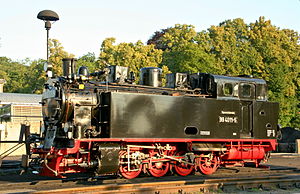MBB No. 6 to 11
| Mansfeder Mining Railway No. 6 II to 11 II | |
|---|---|
|
99 4011 in Putbus (2012)
|
|
| Numbering: | Locomotive 6-11 |
| Number: | 6th |
| Manufacturer: | Orenstein & Koppel |
| Year of construction (s): | 1931-1936 |
| Type : | D h2t |
| Genre : | K44.9 |
| Gauge : | 750 mm |
| Length over coupling: | 9,040 mm |
| Smallest bef. Radius: | 60 |
| Empty mass: | 31.3 t |
| Service mass: | 38 t |
| Friction mass: | 38 t |
| Wheel set mass : | 9.5 t |
| Top speed: | 35 km / h |
| Indexed performance : | 450 hp |
| Driving wheel diameter: | 800 mm |
| Number of cylinders: | 2 |
| Cylinder diameter: | 400 mm |
| Piston stroke: | 400 mm |
| Boiler overpressure: | 16 bar |
| Number of heating pipes: | 12 |
| Number of smoke tubes: | 74 |
| Heating pipe length: | 2800 mm |
| Grate area: | 1.5 m² |
| Radiant heating surface: | 6 m² |
| Tubular heating surface: | 50.3 m² |
| Superheater area : | 26 m² |
| Water supply: | 3.9 m² |
| Fuel supply: | 2.6 tons of coal |
| Train heating: | steam |
| Coupling type: | Compensating coupling |
| Particularities: | Trofimow type |
The vehicles with the numbers 6 II to 11 II of the Mansfeld mining railway were narrow-gauge tank locomotives for use on their works railway network.
history
In 1931, Mansfeld AG for Mining and Metallurgy procured four new superheated steam locomotives of the type Dh2t with the serial numbers 12347-12350 from Orenstein & Koppel for the commencement of large-capacity freight wagons and rolling wagons on the Mansfeld mine railway. They were assigned the company numbers 6-11 in a second occupation. The main task of the approximately 350 hp (on the towing hook) and 38 t heavy locomotives was to transport trolleys and ore trains, and later also passenger trains to the shafts.
In the 1950s, the locomotives were given connections for the main air reservoir line, so that corresponding wagons could be tipped with air (the wagons converted for kaolin transport can be viewed in Mügeln). In the case of locomotives 7 II and 9 II , however, they were omitted during the last refurbishment.
The power of the locomotive is sufficient to carry a train of 140 t uphill on a straight slope of 1:67 (maximum slope on the RüBB) at 30 km / h. On the Mansfeld mining railway, 120 t (four cars) were driven on the 1:30 slope.
technical features
Like the new self-unloading and rolling wagons from MBB, the locomotives had the continuous compressed air brakes that are common on standard-gauge railways. To protect the staff from the rigors of the weather, the driver's cab could be completely closed by means of revolving doors and sliding windows. The locomotives were delivered from the factory with connections for steam heating. The electrical lighting and a hot steam thermometer were also part of the initial equipment. The locomotives still do not have a manometer for valve box pressure. A bell on the top of the boiler can be operated via a chain.
Conversions
In the 1960s, locomotive 10 II ran with oil main firing for about three years, making it the first oil main-fired narrow-gauge locomotive in the GDR.
Locomotive 7 II , today's 99 4011-5, received some modifications during the general inspection in 2012. Among other things, it received new Trofimoff slides , new water tanks and a new coal tank base. It also received four new axle shafts, eight new wheel tires, two new coupling rods, new swing arms, a new Kuhn loop and a new brake linkage. In order to achieve the correct coupling height, the coupling hoses of the main air line were set lower.
Whereabouts
Except for locomotive number 8 II , which had an accident and was then scrapped because of it, all the locomotives still exist. The Mansfeld Combine numbered all locomotives, narrow-gauge and regular-gauge locomotives from 1 in ascending order. At the time of the accident with locomotive 8 II , there were regular-gauge diesel locomotives that were numbered up to number 5. Another diesel locomotive was procured for the standard gauge, which had to be included in the number system of the Mansfeld Combine that was in effect until then. The next number was 6, but it was already assigned to the steam locomotive 6 II of the narrow-gauge railway. For this reason, locomotive 6 II was given the number of the accident-damaged and scrapped locomotive 8 in the third occupation and could then integrate the standard gauge diesel locomotive procured into the numbering system.
The locations are as follows:
- Locomotive 7 II : sold to EBG Prora, which also sold this locomotive a few years ago. Now it is in use at the Rügen Bäderbahn as 99 4011-5.
- Locomotive 8 III : Monument locomotive in the Mansfeld Museum in Hettstedt.
- Locomotive 9 II : Sold to and in service with the Yekaterinburg Children's Railway.
- Locomotive 10 II : Stored in the Hettstedt locomotive shed.
- Locomotive 11 II : Stored in the Hettstedt engine shed.
